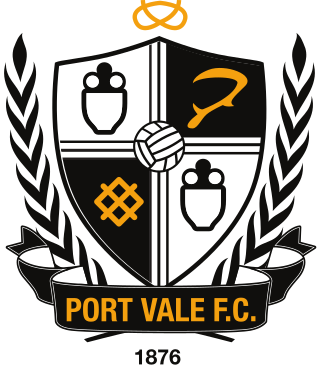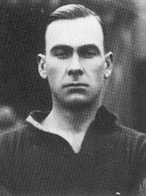
Port Vale Football Club are a professional football club based in Burslem, Stoke-on-Trent, England, which compete in EFL League One. Vale are named after the valley of ports on the Trent and Mersey Canal. They have never played top-flight football, and hold the record for the most seasons in the English Football League (112) without reaching the first tier. After playing at the Athletic Ground in Cobridge and The Old Recreation Ground in Hanley, the club returned to Burslem when Vale Park was opened in 1950. Outside the ground is a statue to Roy Sproson, who played 842 competitive games for the club. The club's traditional rivals are Stoke City, and games between the two are known as the Potteries derby.
Robert Fitzgerald Earle MBE is an English-born Jamaican former international footballer who played as an attacking midfielder. He played 578 league games in senior club football, scoring 136 goals.
Clinton William Boulton was an English professional footballer. A defender, he made 506 league appearances in a 14-year career in the Football League.

Andrew Michael Porter is an English former professional footballer turned coach and manager who is a first-team coach at Northern Premier League Division One West club Nantwich Town. His playing career spanned from 1986 to 2006 and for the majority of his career he played for Port Vale. His successes with the club include winning promotion out of the Third Division via the play-offs in 1989, lifting the Football League Trophy in 1993, and playing in the final of the Anglo-Italian Cup in 1996. He later played for Wigan Athletic, Mansfield Town, Chester City, Northwich Victoria, and Kidsgrove Athletic.

The Port Vale Player of the Year award is voted for annually by Port Vale's supporters in recognition of the best overall performance by an individual player throughout the football season. Towards the end of each season, fans are invited to cast their votes for this award.
David Harris is an English former football defender who had a six-year professional career in the English Football League with Port Vale from 1973 to 1979. He was voted the club's Player of the Year in 1974 and 1977. He then spent two seasons with Halifax Town, before entering the non-League scene with Stafford Rangers.
Henry Poole was an English professional footballer, noted for his swerving free kicks. Primarily a half back, he had the third highest number of appearances for Port Vale. He made 499 league and cup appearances for the club in a fifteen-year association from 1953 to 1968. Whilst Poole was at the club, the "Valiants" won the Fourth Division title in 1958–59.
Phillip Jess Sproson is an English former footballer who played as a central defender. He played in 500 matches for Port Vale and scored 41 goals, this places him second in the list of appearances for Port Vale. He was the nephew of Port Vale defender Roy Sproson and son of Jess Sproson, who played for Vale between 1940 and 1947.

The history of Port Vale Football Club, an English association football club based in Stoke-on-Trent, began with the formation of the club, which is officially dated at 1876, though later research has shown this event probably took place in 1879. In 1884, the club moved to the town of Burslem, changing their name to Burslem Port Vale in the process. The club joined the Football League Second Division upon its formation in 1892, and spent 13 non-consecutive seasons in the division, punctuated by two seasons in the Midland League. A financial crisis resulted in the club's liquidation in 1907, though the name of Port Vale F.C. survived as North Staffordshire Federation League side Cobridge Church took on the name and moved into the Old Recreation Ground in Hanley, before progressing through the divisions to win re-election to the Football League in October 1919.
Terrence Miles is an English former professional footballer. A midfielder, he played for Port Vale between 1955 and 1968, helping them to the Fourth Division title in 1958–59. He later turned out for Sandbach Ramblers and Eastwood, before returning to Vale Park as a coach.
Thomas Lawrence Hamlett was an English footballer who played at right-back for Congleton Town, Bolton Wanderers, and Port Vale. He scored nine goals in 181 league appearances in the six seasons of the Football League immediately following World War II. He later spent 25 years on the coaching staff at Port Vale, from July 1958 to March 1983.

The 1946–47 season was Port Vale's 35th season of football in the English Football League, and their second full season in the Third Division South. It was their first full season following the outbreak of war in Europe, they thus continued where they left off in 1938–39, albeit after seven seasons of wartime football. Starting its post-war period modestly on the pitch with a tenth-place finish, the club still handed débuts to future legends Tommy Cheadle and Ronnie Allen, whilst work continued to complete 'The Wembley of the North'.

The 1949–50 season was Port Vale's 38th season of football in the English Football League, and their fifth full season in the Third Division South. It was the last season to be played at The Old Recreation Ground – despite numerous clashes with the authorities over the construction of the new stadium. The sale of Ronnie Allen raised a massive £20,000.

The 1950–51 season was Port Vale's 39th season of football in the English Football League, and their sixth full season in the Third Division South. It was the first season to be played at Vale Park, and Roy Sproson also made his debut for the club. In the FA Cup there was excitement as the Vale took rivals Stoke City to a replay in the Fourth Round, only to lose 1–0. It was the last season in the reign of Gordon Hodgson, who died in the summer after long suffering from cancer.
The 1958–59 season was Port Vale's 47th season of football in the English Football League, and their first season in the newly created Fourth Division following their relegation from the Third Division South. They scored a club-record 110 goals in 46 league matches to storm to the Fourth Division title. Forwards Stan Steele, Jack Wilkinson, Graham Barnett, Harry Poole, and John Cunliffe all reached double-figures in front of goal.
The 1967–68 season was Port Vale's 56th season of football in the English Football League, and their third-successive season in the Fourth Division. A poor season saw them battle to mid-table in order to avoid the re-election zone. Yet it would be off-the-field developments that would worry Vale supporters the most. An FA/Football League Joint-Inquiry investigated the club as club officials were forced to admit several breaches of the rules in regard to payment of players. The result was expulsion from the League, however, before the start of the following season a vote of 39 to 9 allowed the club to be immediately readmitted to the competition. The whole saga was rather ironic, as the club re-entered the League in 1919 after Leeds City were expelled over illegal payments to their players. On the playing front it was the final season of both Harry Poole and Terry Miles' careers.
The 1989–90 season was Port Vale's 78th season of football in the English Football League, and first season back in the Second Division following their promotion from the Third Division. They were playing in the second tier, and at the same level as rivals Stoke City, for the first time since 1956–57. John Rudge led his side to a comfortable mid-table finish, whilst Stoke suffered relegation in bottom place despite the two derby matches finishing in draws. After beating top-flight Derby County, Vale exited the FA Cup at the Fourth Round with their biggest ever loss in the competition, losing 6–0 to Aston Villa at Villa Park. They left both the League Cup and the Full Members Cup at the Second Round.
The 1990–91 season was Port Vale's 79th season of football in the English Football League, and second-successive season in the Second Division. For the first time since 1926–27 they played in a league above rivals Stoke City. Vale finished in mid-table, exiting the FA Cup at the Fourth Round, the League Cup at the Second Round, and the Full Members' Cup at the First Round. John Rudge continued to uncover hidden 'gems', signing Dutchman Robin van der Laan for £80,000. Darren Beckford was top-scorer once again, though the club's Player of the Year award went to Ray Walker.
William Thomas Bell was an English businessman and football club chairman who was the chair of Port Vale from 1987 to 2002. He spent the first twelve years at the club in partnership with manager John Rudge, until he controversially sacked Rudge in January 1999. During his time as chairman he concentrated his efforts on renovating and modernising Vale Park, at great financial cost. However, the money for his ambitious projects dried up with his decision to axe Rudge, and he left the club in December 2002 when Port Vale entered administration.

Nathan James Smith is an English professional footballer who plays as a defender for EFL League One club Port Vale, where he is also club captain. He has won praise for mental attributes such as bravery, consistency and commitment, as well as for his pace and strength.








